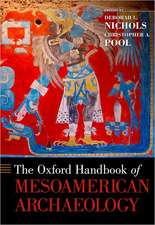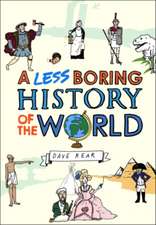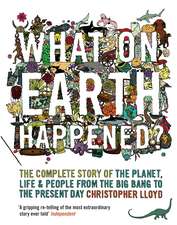Encyclopedia of the Black Death
Autor Joseph P. Byrneen Limba Engleză Paperback – 29 noi 2023
| Toate formatele și edițiile | Preț | Express |
|---|---|---|
| Paperback (1) | 135.95 lei 6-8 săpt. | |
| Bloomsbury Publishing – 29 noi 2023 | 135.95 lei 6-8 săpt. | |
| Hardback (1) | 402.13 lei 6-8 săpt. | |
| Bloomsbury Publishing – 15 ian 2012 | 402.13 lei 6-8 săpt. |
Preț: 135.95 lei
Preț vechi: 143.10 lei
-5% Nou
Puncte Express: 204
Preț estimativ în valută:
26.02€ • 27.06$ • 21.48£
26.02€ • 27.06$ • 21.48£
Carte tipărită la comandă
Livrare economică 15-29 aprilie
Preluare comenzi: 021 569.72.76
Specificații
ISBN-13: 9798765114148
Pagini: 452
Ilustrații: 43 bw illus
Dimensiuni: 178 x 254 x 22 mm
Greutate: 0.78 kg
Editura: Bloomsbury Publishing
Colecția Bloomsbury Academic
Locul publicării:New York, United States
Pagini: 452
Ilustrații: 43 bw illus
Dimensiuni: 178 x 254 x 22 mm
Greutate: 0.78 kg
Editura: Bloomsbury Publishing
Colecția Bloomsbury Academic
Locul publicării:New York, United States
Caracteristici
300 A-Z interdisciplinary entries on medical matters and historical issues
Notă biografică
Joseph P. Byrne is a historian and professor of honors humanities at Belmont University, Nashville, TN, USA.
Cuprins
List of Entries by Broad TopicIntroductionTimelineAbandonmentAIDS and Plagueal-Asqalani, Ibn Hajar (1372-1449)AlchemyAllahAlmanacsal-Manbiji, Muhammad (d. 1383)al-Maqrizi, Muhammad (al-Makrizi; 1363/4-1442)Amulets, Talismans, and MagicAnatomy and DissectionAnimalsAnticlericalismAnti-Semitism and Anti-Jewish Violence before the Black DeathApocalypse and ApocalypticismApothecariesArabic-Persian Medicine and PractitionersArmenian BoleArmiesArrowsArs moriendi (The Art of Dying)Art, Effects of Plague onArticellaAstrologyAthens, Plague ofAvicenna (Abu Ali al-Husayn ibn Abd Allah ibn Sina; 980-1037)Barcelona, SpainBellsBertrand, Jean-Baptiste (1670-1752)Bezoar StonesBibleBiblical PlaguesBills of HealthBills of MortalityBimaristans (also Maristans)Bishops and PopesBlack Death (1347-1352)Black Death: Debate over the Medical Nature ofBlack Death: Origins and Early SpreadBlack Death, Plague, and Pestilence(Terms)Bleeding/PhlebotomyBoccaccio, Giovanni (1313-1375)Books of HoursBorromeo, Federigo (1564-1631)Borromeo, St. Charles (SanCarlo; 1538-1484)Boyle, Robert (1627-1691)Broadsheets, Broadsides, and PamphletsBubonic PlagueBubonic Plague in North AmericaBullein, William (d. 1576)Caffa (Kaffa, Feodosiya), UkraineCairo, EgyptCanutus (Kanutus) Plague TractCauses of Plague: Historical TheoriesCellites and AlexiansCharlatans and QuacksChaucer, Geoffrey (c. 1340/43-1400)Chauliac, Guy de (Guido de Cauliaco; c. 1300-1367)ChildrenChinaChinese Traditional MedicineChristChronicles and AnnalsChurches, PlagueCiompi RevoltClement VI, Pope (1291/92-1352; r. 1342-1352)ClothingCompendium of ParisConfraternitiesConsilia and Plague TractsConstantinople/IstanbulContagion TheoryCordons SanitairesCorpse CarriersCorpsesCouvin, Simon de (Symon de Covino; c. 1320-1367)Crime and PunishmentDancing ManiaDanse MacabreDeath, Depictions ofDefoe, Daniel (1660-1731)Dekker, Thomas (1570?-1632)De Mertens, Charles (1737-1788)Demographic and Economic Effects of Plague: The Islamic WorldDemographic Effects of Plague: Europe 1347-1400Demographic Effects of Plague: Europe 1400-1500Demographic Effects of Plague: Europe 1500-1722DemographyDemons, Satan, and the DevilDiagnosing PlagueDietary RegimensDiseases, Opportunistic and SubsidiaryDisinfection and FumigationDNA and the Second Plague PandemicDonne, John (1572-1631)DoorsDublin, IrelandEarthquakesEconomic Effects of Plague in EuropeEmpiricsEnd of Second Plague Pandemic: TheoriesEpidemic and PandemicEx votoExpulsion of VictimsEyam, England (1666)FamineFernel, Jean (c. 1497-1558)Feudalism and ManorialismFicino, Marsiglio (1433-1499)FlagellantsFleasFlightFlorence, ItalyFracastoro, Girolamo (1478-1553)Friars (Mendicants)Funerals, CatholicFunerals, MuslimFunerals, ProtestantGalen and Galenism (129CE-c.216)Gentile da Foligno (c. 1275-1348)Germ TheoryGod the FatherGoldGovernments, CivilGraunt, John (1620-1674)GravediggersGregory the Great, Pope (r.590-604)Grindal, Edmund (1519-1583)GuildsHealth Boards, Magistracies, and CommissionsHeaven and HellHenry VIII, King of England (1491-1547; r. 1509-1547)Hippocrates (c. 460-c. 360 bce) and the Hippocratic CorpusHodges, Nathaniel (1629-1688)HospitalsHumoral TheoryHundred Years War (1337-1453)I promessi sposi (1827)Ibn al-Khatib, Lisad-ad Din (1313-1374)Ibn Battuta, Abu Abdullah (1304-1368)Ibn Khatimah, Abu Jafar Ahmed (1323?-1369)Individualism and Individual LibertiesIngrassia, Giovanni Filippo (Gianfilippo; 1510-1580)Islam and MedicineIslamic Civil ResponsesIslamic Religious ResponsesIslip, Simon (d. 1366)Issyk Kul, KyrgystanJacquerieJames I and VI Stuart, King (1566-1625)Jewish Treasure HoardsJewsJinnJobJohn of Burgundy (c. 1338-1390; also Johannes de Burgundia, Burdeus, La Barba, Burgoyne)Jonson, Ben (1572-1637)Justinian, Plague of (First PlaguePandemic)Kircher, Athanasius (1602-1680)Kitasato, Shibasaburo (1852-1931)Koch, Robert (1843-1910)Labourers, Ordinance and Statute ofLangland, William (c.1325-after 1388)Languages: Vernacular and LatinLazarettos and Pest HousesLazarusLeechbooksLeprosy (Hansen's Disease) and LeprosariumLi Muisis, Gilles (Le Muisit; 1271/72-1353)Little Ice AgeLollardsLondon, EnglandLondon, Great Plague of (1665-1666)London's East Smithfield Plague CemeteryLuther, Martin (1483-1546)Lydgate, John (c. 1370-1450)MalthusianismMarseille, FranceMass Graves and Plague CemeteriesMead, Richard (1673-1754)MeccaMedical Education (1300-1500, Medieval Europe)Medical Education (1500-1700, Early Modern Europe)Medical HumanismMerchantsMercuriale, Girolamo (1530-1606)Metaphors for PlagueMiasma TheoryMilan, ItalyMongolsMonks, Nuns, and MonasteriesMoral LegislationMorality Literature, ChristianMorbidity, Mortality, and VirulenceMoscow, RussiaMuhammad the Prophet (570-632)Naples, ItalyNarwhal/Unicorn Horn PowderNashe, Thomas (1567-1601)NobilityNotariesNursesParacelsus (1493-1541) and ParacelsianismParets, Miquel (1610-1661)Paris, FranceParishPasteur, Louis (1822-1895)Pastors, Preachers, and MinistersPeasantsPeasants' Revolt, EnglishPepys, Samuel (1633-1703)Petrarch, Francesco (1304-1374)PhysiciansPhysicians, CourtPhysicians, TownPilgrims and PilgrimagePlague in Europe, 1360-1500Plague in Europe, 1500-1725Plague MemorialsPlague Orders and National AuthoritiesPlague SaintsPlague Stone"Plagues" in the West, 900-1345Pneumonic PlaguePoetry, EuropeanPoetry, IslamicPoisoning and Plague SpreadingPoverty and PlaguePrayer and FastingPriestsPrintingPrisonersProcessionsProphylaxesProstitutesPublic HealthPublic SanitationPurgativesPurgatoryQuarantineRats and Other Plague CarriersReformation and ProtestantismRemedies, ExternalRemedies, InternalRepopulationRome, ItalySt. Januarius (San Gennaro; d.c.305)St. Michael the ArchangelSt. Nicholas of Tolentino (1245-1305)St. RocheSt. RosaliaSt. SebastianScientific RevolutionSearchersSecond Plague Pandemic (1340s-1840s)Septicemic PlagueServants, HouseholdShakespeare, William (1564-1616)Shutting InSigns of PlagueSimond, Paul-Louis (1858-1947)SinSocial Construction of DiseaseSumptuary LawsSurgeons/BarbersSydenham, Thomas (1625-1689)Syrups and ElectuariesTa'unTaxes and Public FinanceTears against the PlagueTheriac and MithridatumThird Plague PandemicThirty Years' War (1618-1648)"Three Living Meet Three Dead"ToadsTobaccoTransi TombsTriumph of DeathTumbrelsUrine and UroscopyValesco de Tarenta (d.after1426)Van Diemerbroeck, Isbrand (Ysbrand, IJsbrand; 1609-1674)Van Helmont, Joan Baptista (Johannes; Jan; 1579-1644)Venice, ItalyVesalius, Andreas (1514-1564)Vienna, AustriaVinario, Raimondo Chalmel de (Magister Raimundus; Chalmelli; Chalin; d. after 1382)Virgin MaryVirgin Soil DiseaseWandsWills and TestamentsWitches and WitchcraftWither, George (1588-1667)Women Medical PractitionersYeoman Farmers and GentryYersin, Alexandre (1863-1943)Yersinia pestisZodiac ManGlossaryBibliographyIndex
Recenzii
Joseph Byrne, a medievalist well versed in myriad aspects of the period, displays his command of the era by examining aspects of bubonic plague. His skill at humanistic analysis reaches a height in such topics as virgin soil disease, medical education, remedies, and repopulation. . . . Overall, the comprehensive A to Z entries, timeline, maps and illustrations, bibliography, glossary, and detailed index provide high school, public, and college and university libraries with a valuable tool for understanding one of Earth's most terrifying catastrophes.
I found this a very interesting reference work which examines the profound effect the epidemic had on the social and political landscape in European and Islamic countries as well as changes in medicine, medical studies and government-controlled public health policies. . . . Overall, this is a work which I think expands knowledge of the plague, not just during the period of the official Black Death, but also by providing the context of all three pandemics, how each one relates to the other, and how society, biomedicine, public health and politics respond to these crises, and developed as a result. This book would be an excellent addition to academic e-collections, of particular interest to humanities students of all disciplines, and historians. Scientists studying the history of medicine and biomedicine may also find this useful.
This is a terrific subject encyclopedia. . . . This will be a very useful acquisition for academic libraries in particular, especially those at institutions with programs in medieval history, history of science, and the humanities. Highly recommended.
The work begins with a helpful list of entries by topic (among them, 'Arts and Literature,' 'Biomedical Causes and Issues,' and 'Religion') and a time line. Entries are short, running one to two pages, and cover the typical (Alchemy, Animals, Fleas, Mass graves and plague cemeteries) and the unexpected ( Abandonment, Purgatory, Sumptuary laws) as well as many of the notable people of the times. The writing is clear and straightforward. All entries conclude with a list of references, and see also references are included, where helpful. A glossary, an extensive bibliography, and a general index round out the work. This single-volume resource will serve as a good starting point for research on the Black Death.
I found this a very interesting reference work which examines the profound effect the epidemic had on the social and political landscape in European and Islamic countries as well as changes in medicine, medical studies and government-controlled public health policies. . . . Overall, this is a work which I think expands knowledge of the plague, not just during the period of the official Black Death, but also by providing the context of all three pandemics, how each one relates to the other, and how society, biomedicine, public health and politics respond to these crises, and developed as a result. This book would be an excellent addition to academic e-collections, of particular interest to humanities students of all disciplines, and historians. Scientists studying the history of medicine and biomedicine may also find this useful.
This is a terrific subject encyclopedia. . . . This will be a very useful acquisition for academic libraries in particular, especially those at institutions with programs in medieval history, history of science, and the humanities. Highly recommended.
The work begins with a helpful list of entries by topic (among them, 'Arts and Literature,' 'Biomedical Causes and Issues,' and 'Religion') and a time line. Entries are short, running one to two pages, and cover the typical (Alchemy, Animals, Fleas, Mass graves and plague cemeteries) and the unexpected ( Abandonment, Purgatory, Sumptuary laws) as well as many of the notable people of the times. The writing is clear and straightforward. All entries conclude with a list of references, and see also references are included, where helpful. A glossary, an extensive bibliography, and a general index round out the work. This single-volume resource will serve as a good starting point for research on the Black Death.











